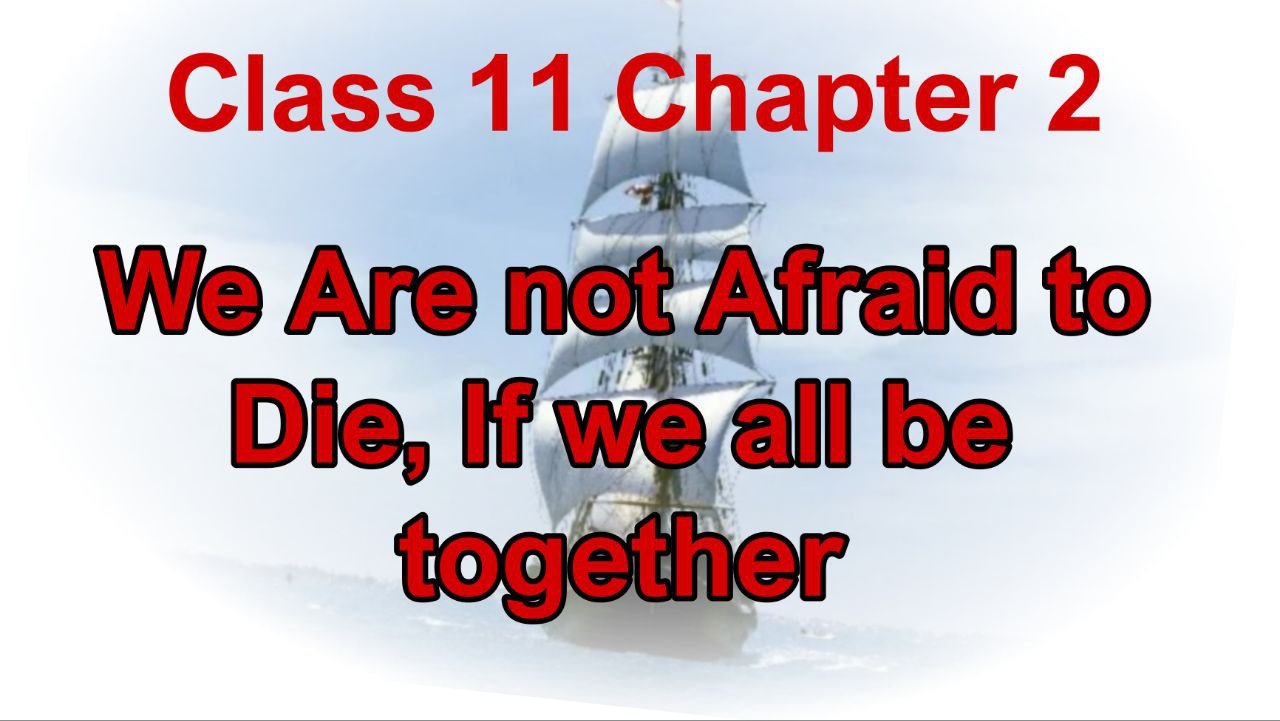NCERT Solutions for Class 11 English Chapter 2 – We’Re Not Afraid To Die, If We Can All Be Together
Class 11 English Chapter-2 NCERT Solutions – We’re Not Afraid to Die, if We Can All Be Together
Chapter 2 (We’re Not Afraid to Die)
We’re Not Afraid to Die UNDERSTANDING THE TEXT
Q. List the steps taken by the captain
(i) to protect the ship when the rough weather began.
(ii) to Check the flooding of the water in the ship
Answer.
i. The steps taken by the captain to protect the ship when the rough weather began were- The captain dropped the storm jib and lashed a heavy mooring rope in the form of a loop across the stern to slow the boat down.
•Everything was double-lashed and the raft drill was gone through.
ii. The steps taken by the captain to check the flooding of the water in the ship were-
The canvas was stretched and the gaping holes were blocked with waterproof hatch covers. This helped most of the water deflate to the sides although some of it was still seeping in.
•The author also found a second electric pump when the first one went out of service.
Q. 2 Describe the mental condition of the voyagers on 4 and 5 January.
Answer: The mental condition of the voyagers on January 4 was oscillating between hope and despair. The water had finally receded after about thirty-six hours of continuous pumping out water. They were given the very first meal in the last two days. This meal was given to them by the Captain’s wife. The meal consisted of some corned beef and cracker
biscuits. After this the storm started building up badly. And on 5th January the situation deteriorated and became desperate. When the Captain went to console his kids, the younger kid asked him innocently if they all were about to die. He also added that he wouldn’t be afraid if they were all together. This strong statement made the Captain confident and he began to fight for sustenance.
Q.3 Describe the shifts in the narration of the events as indicated in the three sections of the text. Give a subtitle to each section.
Answer. The initiation-
The initiation shows the building of the strong ship ‘wave-walker’. The ship was professionally built and innumerable enthusiastic preparations were made in 1976 by the author and his family. The wave-walker had completed the first phase of the three year-journey very nicely when they were entering the Southern Indian Ocean.
So the Captain hired two American men namely American Larry Vigil and Swiss Herb Stigler to help the Captain one of the world’s roughest seas. A certain shift in the narration in the first section is noticed when the ship encounters an atrocious weather when the high sea waves created a havoc. The waterstarted seeping into the boot and to top it all, the Captain met with an accident. Even though the situation had only deteriorated, the best part was that everything was being handled by the people together as a family.
TALKING ABOUT THE TEXT
Q. I Discuss the following questions with your partner.
What difference did you notice between the reaction of the adults and thechildren when faced with danger?
Answer: The reaction of the children was much different from that of the adults. The adults were hopeful in the beginning. But the children were hopeful even when all the adults had lost hope. Whenever there was a strain of hopefulness, the children made sure that the elders were fully supported by them emotionally and mentally. They never lost hope.
Q. 2 Discuss the following questions with your partner.
How does the story suggest that optimism helps to endure “the direst stress”?
Answer The story swings between hope and despair continuously. This shows how family members can stand beside one another and manage the entire situation wisely and wonderfully. The Captain’s wife stayed at the wheels at the most crucial hours of the journey and saved the ship. The Captain himself didn’t let the ship deviate and took it towards the island in the correct time. Also, his seven years old daughter didn’t let him worry about her head injury and gave him hopes. And his son was not afraid to die.
Q. 3 Discuss the following questions with your partner.
What lessons do we learn from such hazardous experiences when we are face-to-face with death?
Answer: The lessons that we learn from such hazardous experiences when we are face-to-face with death is that man should be brave enough. An optimistic and brave person can struggle through any kind of situation and emerge victoriously.
Q.4 Discuss the following questions with your partner.
Why do you think people undertake such adventurous expeditions in spite of the risks involved?
Answer: Most people usually wish to lead a hustle free life. But it is only because of brave people like the Captain himself that we are able to discover new lands and connect with one another. This urge enables a person to excavate the extraordinary. The urge to push beyond the comfort zone just to know the world is an awesome feeling.
THINKING ABOUT LANGUAGE
Q. I We have come across words like ‘gale’ and ‘storm’ in the account. Here are two more words for storm: typhoon, cyclone. How many words does your language have for ‘storm”?
Answer. My mother tongue is Bengali. And there are innumerable words in my language for a storm. They are Jhor, bristi etc.
NOTE- Use any word that is the synonym for storm in your own language and write it here. Answers can be different.
Q. 2 Here are the terms for different kinds of vessels: yacht, boat, canoe, ship, steamer, schooner. Think of similar terms in your language.
Answer: The various types of vessels in Bengali are-nouko, jahaj etc.
NOTE- Use any word that is the synonym for a vessel in your own language and write it here. Answers can be different.
Q.3 “Catamaran’ is a kind of a boat. Do you know which Indian language this word is derived from? Check the dictionary.
Answer: The Indian language from which the word “Catamaran is derived from is Tamil.

